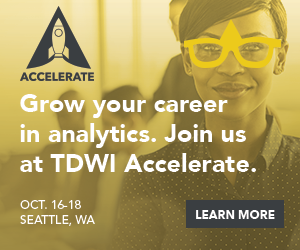By Meighan Berberich, President, TDWI

Analytics and data science have moved to the forefront of business decision making. The size and scope of the organizations and the complexity of tools and technologies that support these mission critical initiatives only continues to grow. It is critical for analytic leaders to maintain focus on the key factors that drive success of their analytics teams and deployments.
TDWI Accelerate will not only provide analytics leaders with insight on what’s new (and what’s next) in advanced analytics, but also on the factors beyond technology that are instrumental to driving business value with data.
Check out our leading sessions during this interactive and engaging three day event:

 Building a High-Performance Analytics & Data Science Team
Building a High-Performance Analytics & Data Science Team
Bill Franks, Chief Analytics Officer, International Institute for Analytics
This talk will discuss a variety of topics related to how a successful modern-day analytics and data science organization can grow, mature, and succeed. Topics will include guidance on organizing, recruiting, retaining, and instilling a winning culture within an analytics and data science organization.
 Pay No Attention to the Man behind the Curtain
Pay No Attention to the Man behind the Curtain
Mark Madsen, President, Third Nature, Inc.
Using data science to solve problems depends on many factors beyond technology: people, skills, processes, and data. If your goal is to build a repeatable capability then you need to address parts that are rarely mentioned. This talk will explain some of the less-discussed aspects of building and deploying machine learning so that you can better understand the work and what you can do to manage it.
 From BI to AI - Jumpstart your ML/AI projects with Data Science Super Powers
From BI to AI - Jumpstart your ML/AI projects with Data Science Super Powers
Wee Hyong Tok, Principal Data Science Manager, Microsoft Corporation
Why do some companies drown in volumes of data, while others thrive on distilling the data in the data warehouses/databases into golden strategic advantages? How do business stakeholders and data scientists work together to evolve from BI to ML/AI, and leverage data science in co-creating new value for the company? Join Wee Hyong in this as he shares with you 5 super powers that will help you jumpstart your ML/AI projects.
 Designing for Decisions
Designing for Decisions
Donald Farmer, Principal, TreeHive Strategy
Over the years, Business Intelligence has grown in many directions. Today, the practice can include data mining, visualization, Big Data and self-service experiences. But we’re still, fundamentally, in the business of decision support.
As analysts and developers we can support better business decisions more effectively if we understand the cognitive aspects of data discovery, decision making and collaboration. Luckily, we have a wealth of fascinating research to draw on, ranging from library science to artificial intelligence research.
We’ll explore the implications of some of this research, in particular how we can design an analytic experience that leads to more engaging, more insightful and measurably better decision-making.
View the complete agenda of more than 30 session across 3 days.
The time is now. The demand for skills in analytics and data science has reached an all-time high. Everywhere, organizations are building advanced analytics practices to drive business value, improve operations, enrich customer experiences, and so much more.
Build your expertise. Drive your organization’s success. Advance your career. Join us at TDWI Accelerate, October 16-18 in Seattle, WA.
Posted on July 21, 20170 comments
By Meighan Berberich, President, TDWI

Data prep. Wonderful, terrible data prep. According to John Akred of Silicon Valley Data Science, “it’s a law of nature that 80% of data science” is data prep. Although our surveys average closer to 60%, even that’s an awful lot of time to spend not analyzing data, interpreting results, and delivering business value—the real purpose of data science.
Unfortunately, real-world data doesn’t come neatly prepackaged and ready to use. It’s raw, messy, sparse, and exists across a million disparate sources. It can be dirty, poorly formatted, unclear, undocumented, or just plain wrong. One can easily see what makes Exaptive data scientist, Frank Evans, ask “Are we data scientists or data janitors?”
The news isn’t all bleak, though. If there’s one thing we know, it’s that the data scientist’s mindset is perfectly suited to grappling with a seemingly intractable problem and coming up with answers. For example, even Evans’ cynical-seeming question isn’t offered without some solutions.
“Most projects are won or lost at the wrangling and feature engineering stage,” Evans says. “The right tools can make all the difference.” We have a collection of best practices and methods for wrangling data, he offers, such as reformatting it to make it more flexible and easier to work with. There are also methods for feature engineering to derive the exact elements and structures that you want to test from raw data.
Akred is similarly solutions-oriented. His many years of experience applying data science in industry has allowed him to develop a framework for evaluating data.
“You have data in your organization. So you need to locate it, determine if it’s fit for purpose, and decide how to fill any gaps,” he says. His experience has allowed him to be equally pragmatic about the necessity to navigate the political and technical aspects of sourcing your data—something that can often be neglected.
Data Exploring—Literally
Wes Bernegger of Periscopic takes a somewhat more playful tack.
“The road to uncovering insight and narratives in your data begins with exploration,” he says. “But though there are all kinds of tools to help you analyze and visualize your data, it’s still mostly an undefined process.” Bernegger suggests coming to the task with the attitude of an old-fashioned explorer.
“If you plan your voyage and are prepared to improvise with relentless curiosity,” he says, “you can often come away with unexpected discoveries and have more fun along the way.” Bernegger advises to lay out a system for the data exploration practice, from wrangling and tidying to visualization, through many rounds of iteration, and to stock up on some tools (such as continuing education) to help you find your way in unfamiliar terrain.
Build your expertise. Drive your organization’s success. Advance your career. Join us at TDWI Accelerate, October 16-18 in Seattle, WA.
Posted on July 19, 20170 comments
By Meighan Berberich, President, TDWI

Communication—the process by which information is exchanged between individuals. In the analytics field, we like to call it “data visualization,” but it’s really just a particular form of communication. There’s nothing special about that. Even bacteria can communicate with each other. So why can it be so difficult for data professionals to get their meaning across?
There are few other areas where Art and Science collide in such a head-on way. Effective data visualization requires its practitioners to be constantly threading the needle between the art of the visual (How many colors is too many? Will viewers tune out at another bar chart?) and the science of the numbers. In addition, there can be a lot riding on a visualization’s effectiveness—business opportunities lost, warning signs missed, promising applications abandoned.
As Nick Kelly, vice president of BluLink Solutions, says, “many analytics projects start well intentioned” but are never fully adopted by frontline business users. Though there are a number of potential reasons, he says, Kelly identifies poor user experience as a common one.
Designing With Data
Dave McColgin, executive creative director of Seattle-based design firm Artefact, takes a broader view. “We’re still exploring and experimenting how we use, share, and communicate huge amounts of information,” he says. Artefact’s own website speaks as much about its data and research efforts than its jazzy portfolio pieces—a rarity among design firms.
“The task is to transform complex information into designs that engage people and empower them to act,” McColgin says.
Not to be outdone, Datarella’s Joerg Blumtritt sees even greater potential. “In addition to data storytelling, data journalism, and even simple dashboards, data has grown into a medium for creative output.”
Blumtritt is a co-author of “The Slow Media Manifesto,” which emphasizes choosing one’s media ingredients slowly and with care. “Contemporary artists are still struggling to find the language for their output in the post-internet age. Parametric design, algorithmic architecture, and rapid prototyping technologies have redefined the relationship between creator and artist tools.”
You can catch more from each of these visionaries at TDWI Accelerate Seattle, October 16-18.

 The Data Scientists Guide to User Experience
The Data Scientists Guide to User Experience
Nick Kelly, Vice President, BluLink Solutions
This session takes a practical approach to addressing user experience problems—from strategies such as conducting user interviews at project inception through to the completion of the project and addressing user adoption and sharing of insights.
- Core UX principles to apply to analytics requirements gathering
- How a workshop format can address stakeholder challenges
- Using wire-framing to design the end state
- Key steps to operationalize insights
- Reasons why sharing and gamification matter
 Beyond Visualization: Designing Data For Insights And Action
Beyond Visualization: Designing Data For Insights And Action
Dave McColgin, Executive Creative Director, Artefact
The attendees of this session will take away tangible methods for approaching designing data for people. Dave will share how leading design and innovation consultancy Artefact approaches the design of data visualization and analytics tools, based on a range of desired outcomes and audiences and using examples from award-winning projects like the SIMBA breast cancer decision tool, USAFacts, and more.
 Data Art: Beyond Infographics
Data Art: Beyond Infographics
Joerg Blumtritt, CEO, Datarella
When it comes to data visualizations, we usually think of infographics. However, contemporary artists have been enacting critical examination of technology and its impact on society, such as surveillance and self-determination. This talk takes you to the very edges of what is being done with data in mediums ranging from video, software, and websites to hardware, kinetic machines, and robotics.
View the complete agenda of more than 30 sessions across 3 days.
The time is now. The demand for skills in analytics and data science has reached an all-time high. Everywhere, organizations are building advanced analytics practices to drive business value, improve operations, enrich customer experiences, and so much more.
Build your expertise. Drive your organization’s success. Advance your career. Join us at TDWI Accelerate, October 16-18 in Seattle, WA.
Posted on July 17, 20170 comments